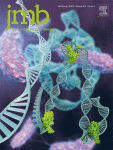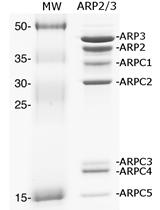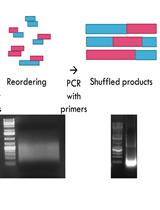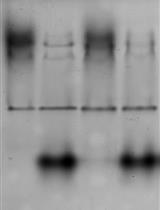- EN - English
- CN - 中文
In vitro and in vivo Assessment of Protein Acetylation Status in Mycobacteria
分枝杆菌中蛋白乙酰化状态的体外和体内检测
发布: 2019年07月05日第9卷第13期 DOI: 10.21769/BioProtoc.3291 浏览次数: 5410
评审: Kristin L. ShinglerDarrell CockburnGunjan Mehta
Abstract
Protein acetylation is one of the standard post-translational modifications found in proteins across all organisms, along with phosphorylation which regulates diverse cellular processes. Acetylation of proteins can be enzymatically catalyzed through acetyltransferases, acetyl CoA synthetases or non-enzymatically through acyl carrier metabolic intermediates. In this protocol, using response regulator proteins as targets we describe the experimental strategy for probing the occurrence of acetylation using purified recombinant proteins in an in vitro setup. Further using M. smegmatis strains overexpressing the wild type or mutant response regulator protein, we also describe how in vivo acetylation can be validated in Mycobacterial proteins. The described approach can be used for analyzing acetylation of any mycobacterial protein under both in vitro and in vivo conditions.
Keywords: TcrX (TcrX)Background
Lysine acetylation is a typical post-translational modification (PTMs) found to be present in proteins across all living organisms. It involves covalent attachment of an acetyl group from acetyl donor, e.g., acetyl phosphate, acetyl CoA, acetate, acetyladenylate, etc. on to the ε-NH2 group of the amino acid lysine in an acceptor protein. Protein acetylation has been extensively studied in context to the histone modification, and for many transcription factors and is associated with regulating chromatin remodeling to cell signaling, antibiotic resistance, environmental stress survival, and metabolism.
While many recent studies have revealed the presence of acetylated proteins in prokaryotes using global proteome analysis approaches, there have been limited attempts to study the impact of acetylation on the function of identified protein due to multistep validation needed for acetylated proteins. For Mycobacterium tuberculosis, which is a slow-growing bacterium, development of highly sensitive mass spectrometry approaches facilitated total acetylome analysis (Liu et al., 2014; Xie et al., 2015), which included many signaling proteins, thus warranting detailed mechanistic analysis of the impact of the identified modification. Recently, the effect of acetylation on the activity of two-component signaling protein DosR in the hypoxic response of Mycobacterium tuberculosis was reported (Bi et al., 2018; Yang et al., 2018). And more recently we demonstrated that acetylation of the response regulator TcrX alters the crosstalk known to be present in two-component signaling systems of M. tuberculosis as well as phosphatase activity of the sensor kinase and DNA binding activity of the response regulator (Singh et al., 2019). During the course of this study, we developed an optimized protocol for in vitro as well as in vivo acetylation analysis of various target proteins which is described here, using the response regulator TcrX as a template. This protocol can be used for testing acetylation status of any mycobacterial protein and involves two steps, first, where the presence of acetylation is probed in vitro in an enzymatically catalyzed reaction and second, the protein is probed for acetylation presence in vivo using M. smegmatis mc2155 as a surrogate host. Utilization of a protein carrying a Lys substitution mutation in vivo helps confirm that the identified Lys is indeed the target acetylation site.
Materials and Reagents
- Pipette tips
- 1 ml tip (Tarsons, catalog number: 521020)
- 2-200 µl (Tarsons, catalog number: 521010)
- 0.2-10 µl (Tarsons, catalog number: 521000)
- 1.5 ml microcentrifuge tubes (Tarsons, catalog number: 500010)
- 15 ml polypropylene centrifuge tubes (Tarsons, catalog number: 546021)
- 50 ml polypropylene centrifuge tubes (Tarsons, catalog number: 546041)
- 0.1 mm diameter zirconia/silica beads (Thomas Scientific, catalog number: 3411F09)
- 2 ml polypropylene bead beating vials (Bio Spec Products Inc., catalog number: 10831)
- PVDF membrane (Bio-Rad, catalog numbers: 1620177 or 1620238)
- Whatman filter paper 1.5 MM (GE Healthcare, catalog number: 10426981)
- 0.45 µm filters (Sartorius Minisart syringe filter, catalog number:16555-K)
- 96-well Micro test plate (Tarsons, catalog number: 941196)
- Expression vector with affinity tag for recombinant protein overexpression and purification (pProEx-Ht vector contains 6x His-tag at the N-terminal has been used for overexpression and purification of TcrX response regulator protein (Agrawal et al., 2015) as well as KATms (acetyl transferase) was a kind gift from Prof. Sandhya Visweswariah, IISc (Nambi et al., 2010)
- Expression strain E. coli BL21 Arctic ExpressTM [B F– ompT hsdS(rB– mB–) dcm+ Tetr gal λ(DE3) endA Hte [cpn10 cpn60 Gentr] (Ferrer et al., 2003) (Agilent Technologies, USA, catalog number: 230191) used for overexpression of TcrX and SP850cyc- strain for KATms as reported (Nambi et al., 2010)
- Mycobacterium smegmatis mc2155 (ATCC, catalog number: 700084)
- pMV261 vector (Received as a kind gift from Prof. Dipankar Chatterji, IISc)
- pMV261 containing a gene coding for TcrX (Singh et al., 2019) or your gene of interest
- pMV261 containing a gene coding for TcrX K231R (Singh et al., 2019) or your gene of interest
- Middlebrook 7H9 medium (BD Biosciences, catalog number: 271310)
- Glycerol (Sisco Research Ltd., catalog number: 62417)
- Tween 80 (Sigma-Aldrich, catalog number: P4780)
- Tween 20 (Sigma-Aldrich, catalog number: P9416)
- Tyloxapol (Sigma-Aldrich, catalog number: T8761)
- Kanamycin (Goldbio, catalog number: K-120)
- Oleic acid (Sigma-Aldrich, catalog number: 75090)
- Albumin (Amersco, catalog number: 0332)
- Dextrose (Sisco Research Ltd., catalog number: 51758)
- Catalase (Sigma-Aldrich, catalog number: C9322)
- Coomassie Brilliant Blue G-250 (Sisco Research Ltd., catalog number: 64222)
- Methanol (Sisco Research Ltd., catalog number: 96446)
- Phosphoric Acid (Alfa Aesar, catalog number: A18067)
- Hydrochloric acid (HCl) (Fisher Scientific, catalog number: A144SI-212)
- Sodium chloride (NaCl) (Merck Millipore Corporation, catalog number: 1064040500)
- Potassium chloride (KCl) (Merck Millipore Corporation, catalog number: 1049360500)
- Di-sodium hydrogen phosphate (Merck Millipore Corporation, catalog number: 1065860500)
- Potassium dihydrogen phosphate (KH2PO4) (Merck Millipore Corporation, catalog number: 1048730250)
- Trizma base (Sigma-Aldrich, catalog number: T6066)
- 2-Mercaptoethanol (Sigma-Aldrich, catalog number: M6250)
- Phenylmethylsulfonyl fluoride (Sigma-Aldrich, catalog number: P7626)
- Benzamidine hydrochloride (Sigma-Aldrich, catalog number: B6506)
- 1% Nonidet-P40 (Sigma-Aldrich, CAS: 9016-45-9)
- Anti-acetyl antibody (Cell Signaling Technology Inc., catalog number: 9441, Dilution 1:7,500)
- HRPO-conjugated secondary antibody (Cell Signaling Technology Inc., catalog number: 7074, Dilution 1:5,000)
- Anti-His antibody (Cell Signaling Technology Inc., catalog number: 2365, Dilution 1:5,000)
- Anti-TcrX polyclonal antibody (Dilution 1:1,000) (generated in the laboratory [Singh et al., 2019])
- Western Lightning PLUS ECL containing enhanced luminol reagent and oxidizing reagent (PerkinElmer, catalog number: NEL100001EA)
- SDS (Affymetrix USB, catalog number: 18220)
- EDTA (Sisco Research Ltd., catalog number: 40648)
- Bromophenol blue (MERCK, catalog number: 1081220005)
- cAMP (Sigma-Aldrich, catalog number: A6885)
- Acetyl CoA (Sigma-Aldrich, catalog number: A2056)
- ADC solution (Albumin, Dextrose, Catalase) (see Recipes)
- 10x acetylation Buffer (see Recipes)
- cAMP, 5 mM stock (see Recipes) (Sigma-Aldrich, catalog number: A6885)
- Acetyl CoA, 5 mM stock (see Recipes) (Sigma-Aldrich, catalog number: A2056)
- 7H9-Glycerol-Tween 80 medium (see Recipes)
- Recovery Media (see Recipes)
- Phosphate buffered saline (see Recipes)
- Lysis buffer (see Recipes)
- 5x Bradford Reagent (see Recipes)
- Storage buffer (see Recipes)
- SDS-PAGE running buffer (see Recipes)
- Transfer buffer (see Recipes)
- Tris Buffer Saline Tween 20 (TBS-T) (see Recipes)
- Stripping Buffer (see Recipes)
- 5x Protein sample buffer (see Recipes)
Equipment
- Pipettes
a.100-1,000 µl pipette (Rainin pipet-lite, catalog number: SL-1000)
b.20-200 µl pipette (Rainin pipet-lite, catalog number: SL-200)
c.2-20 µl pipette (Rainin pipet-lite, catalog number: SL-20)
d.0.1-2 µl pipette (Rainin pipet-lite, catalog number: SL-2) - 2 mm electroporation cuvette (Bio-Rad Laboratories, catalog number: 165-2086)
- Mini-Protean gel electrophoresis system (Bio-Rad Laboratories, model: 165-8000)
- Mini Trans-Blot cell (Bio-Rad Laboratories, model: Trans-Blot® SD cell)
- Gel Doc Imaging System (Bio-Rad Laboratories, model: Universal Hood III)
- 37 °C incubator/shaker (N-BIOTEK, model: NB-205L)
- Refrigerated centrifuge (Thermo Fisher Scientific, model: Sorvall Legend X1R; Hettich Zentrifugen, model: Rotina 420R)
- Spectrophotometer (Eppendorf, BioPhotometer®, model: D30)
- Bead beater (Bio Spec Products, model: Mini-Bead beater)
- Microcentrifuge (Tomy Kogyo Co. Ltd., model: Kitman-T24)
- Vortexes (Shalom Instruments, model: SLM-VM-3000)
- Heating block (heats to 95 °C) (Biobee Lab)
- Ultra-low temperature freezer (Sanyo, model: MDF-U700VX)
- Electroporator (Eppendorf Eporator, catalog number: 4309000019)
- Multimode microplate reader (Tecan, model: Infinite M1000 PRO)
- Autoclave
- -80 °C freezer
Software
- ImageJ https://imagej.nih.gov/ij/download.html
- Image lab version 5.2.1 software from BIO-RAD (used in ChemiDocTM Gel Documentation system)
Procedure
文章信息
版权信息
© 2019 The Authors; exclusive licensee Bio-protocol LLC.
如何引用
Singh, K. K., Singh, D. P., Singh, R. and Saini, D. (2019). In vitro and in vivo Assessment of Protein Acetylation Status in Mycobacteria. Bio-protocol 9(13): e3291. DOI: 10.21769/BioProtoc.3291.
分类
微生物学 > 微生物生物化学 > 蛋白质 > 修饰
分子生物学 > 蛋白质 > 活性
生物化学 > 蛋白质 > 翻译后修饰
您对这篇实验方法有问题吗?
在此处发布您的问题,我们将邀请本文作者来回答。同时,我们会将您的问题发布到Bio-protocol Exchange,以便寻求社区成员的帮助。
提问指南
+ 问题描述
写下详细的问题描述,包括所有有助于他人回答您问题的信息(例如实验过程、条件和相关图像等)。
Share
Bluesky
X
Copy link












